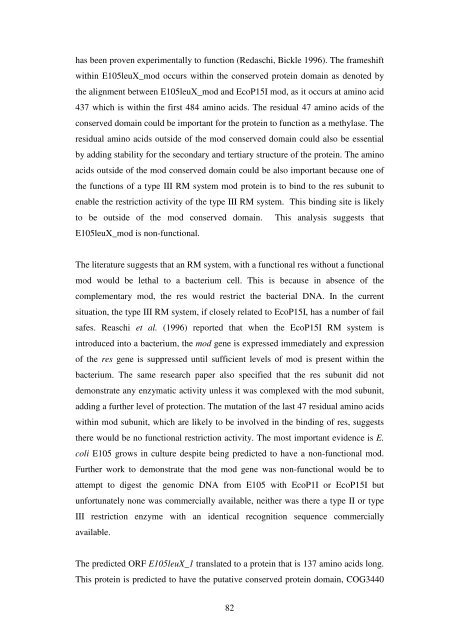5 The role of quorum-sensing in the virulence of Pseudomonas ...
5 The role of quorum-sensing in the virulence of Pseudomonas ...
5 The role of quorum-sensing in the virulence of Pseudomonas ...
You also want an ePaper? Increase the reach of your titles
YUMPU automatically turns print PDFs into web optimized ePapers that Google loves.
has been proven experimentally to function (Redaschi, Bickle 1996). <strong>The</strong> frameshift<br />
with<strong>in</strong> E105leuX_mod occurs with<strong>in</strong> <strong>the</strong> conserved prote<strong>in</strong> doma<strong>in</strong> as denoted by<br />
<strong>the</strong> alignment between E105leuX_mod and EcoP15I mod, as it occurs at am<strong>in</strong>o acid<br />
437 which is with<strong>in</strong> <strong>the</strong> first 484 am<strong>in</strong>o acids. <strong>The</strong> residual 47 am<strong>in</strong>o acids <strong>of</strong> <strong>the</strong><br />
conserved doma<strong>in</strong> could be important for <strong>the</strong> prote<strong>in</strong> to function as a methylase. <strong>The</strong><br />
residual am<strong>in</strong>o acids outside <strong>of</strong> <strong>the</strong> mod conserved doma<strong>in</strong> could also be essential<br />
by add<strong>in</strong>g stability for <strong>the</strong> secondary and tertiary structure <strong>of</strong> <strong>the</strong> prote<strong>in</strong>. <strong>The</strong> am<strong>in</strong>o<br />
acids outside <strong>of</strong> <strong>the</strong> mod conserved doma<strong>in</strong> could be also important because one <strong>of</strong><br />
<strong>the</strong> functions <strong>of</strong> a type III RM system mod prote<strong>in</strong> is to b<strong>in</strong>d to <strong>the</strong> res subunit to<br />
enable <strong>the</strong> restriction activity <strong>of</strong> <strong>the</strong> type III RM system. This b<strong>in</strong>d<strong>in</strong>g site is likely<br />
to be outside <strong>of</strong> <strong>the</strong> mod conserved doma<strong>in</strong>. This analysis suggests that<br />
E105leuX_mod is non-functional.<br />
<strong>The</strong> literature suggests that an RM system, with a functional res without a functional<br />
mod would be lethal to a bacterium cell. This is because <strong>in</strong> absence <strong>of</strong> <strong>the</strong><br />
complementary mod, <strong>the</strong> res would restrict <strong>the</strong> bacterial DNA. In <strong>the</strong> current<br />
situation, <strong>the</strong> type III RM system, if closely related to EcoP15I, has a number <strong>of</strong> fail<br />
safes. Reaschi et al. (1996) reported that when <strong>the</strong> EcoP15I RM system is<br />
<strong>in</strong>troduced <strong>in</strong>to a bacterium, <strong>the</strong> mod gene is expressed immediately and expression<br />
<strong>of</strong> <strong>the</strong> res gene is suppressed until sufficient levels <strong>of</strong> mod is present with<strong>in</strong> <strong>the</strong><br />
bacterium. <strong>The</strong> same research paper also specified that <strong>the</strong> res subunit did not<br />
demonstrate any enzymatic activity unless it was complexed with <strong>the</strong> mod subunit,<br />
add<strong>in</strong>g a fur<strong>the</strong>r level <strong>of</strong> protection. <strong>The</strong> mutation <strong>of</strong> <strong>the</strong> last 47 residual am<strong>in</strong>o acids<br />
with<strong>in</strong> mod subunit, which are likely to be <strong>in</strong>volved <strong>in</strong> <strong>the</strong> b<strong>in</strong>d<strong>in</strong>g <strong>of</strong> res, suggests<br />
<strong>the</strong>re would be no functional restriction activity. <strong>The</strong> most important evidence is E.<br />
coli E105 grows <strong>in</strong> culture despite be<strong>in</strong>g predicted to have a non-functional mod.<br />
Fur<strong>the</strong>r work to demonstrate that <strong>the</strong> mod gene was non-functional would be to<br />
attempt to digest <strong>the</strong> genomic DNA from E105 with EcoP1I or EcoP15I but<br />
unfortunately none was commercially available, nei<strong>the</strong>r was <strong>the</strong>re a type II or type<br />
III restriction enzyme with an identical recognition sequence commercially<br />
available.<br />
<strong>The</strong> predicted ORF E105leuX_1 translated to a prote<strong>in</strong> that is 137 am<strong>in</strong>o acids long.<br />
This prote<strong>in</strong> is predicted to have <strong>the</strong> putative conserved prote<strong>in</strong> doma<strong>in</strong>, COG3440<br />
82














